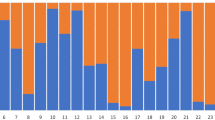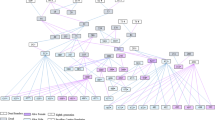Abstract
As part of the species recovery plan for the critically endangered pygmy hog (Porcula salvania), a conservation-breeding program was initiated, to bolster its wild population. For successful conservation-breeding, it is essential to maintain 90% of the founder genetic diversity over time. Therefore, in the present study, we assessed the genetic diversity of a captive population of pygmy hog across generations using a set of ten, cross-specific microsatellite markers. Our results indicated a genetically heterozygous captive population (HE = 0.603), with stable expected heterozygosities across generations. However, the most recent generation showed a significant decrease in individual heterozygosities, implying possible genetic inbreeding. The current findings warrant a need for genetic evaluation to inform future conservation-breeding decisions. In addition, we also designed and tested primers for PCR-based species and sex-identification in the pygmy hog. The markers standardised in the present study would also help in evaluating the survival and ecology of the reintroduced populations.

Similar content being viewed by others
References
Ballou JD (1997) Genetic and demographic modelling for animal colony and population management. ILAR J 38:69–75
Blouch RA (1995) Conservation and Research Priorities for Threatened Suids of South and Southeast Asia. JME 3:21–25
Cain CM, Livieri TM, Swanson BJ (2011) Genetic evalution of a reintroduced population of black-footed ferret (Mustela nigripes). J Mammal 92:751–759
Choudhury A (2006) The status of endangered species in northeast India. JBNHS 103(2/3):157
Costa V, González JP, Santos P, Llario PF, Carranza J et al (2012) Microsatellite markers for identification and parentage analysis in the European wild boar (Sus scrofa). BMC Res Notes 5:479
Deka PJ, Narayan G, Oliver WL, Fa JE (2009) Reintroduced pygmy hogs (Porcula salvania) thrive a year after release—more hogs released in Sonai Rupai Wildlife Sanctuary, Assam, India. Suiform Sound 9:23–28
Funk SM, Verma SK, Larson G, Prasad K, Singh L, Narayan G, Fa JE (2007) The pygmy hog is a unique genus: 19th century taxonomist got it right first time around. Mol Phylogenet Evol 45:427–436
Haye MJJL, Reiners TE, Raedts R, Verbist V, Koelewijn HP (2017) Genetic monitoring to evaluate reintroduction attempts of a highly endangered rodent. Conserv Genet 18:877–892
Kolodziej K, Theissinger J, Brün J, Schulz HK, Schulz R (2012) Determination of the minimum number of microsatellite markers for individual genotyping in wild boar (Sus scrofa) using a test with close relatives. Eur J Wildl Res 58:621–628
Kumar A, Rai U, Roka B, Jha AK, Reddy PA (2016) Genetic assessment of captive red panda (Ailurus fulgens) population. SpringerPlus 5:1750
Luis A, Davidar P, Reddy PA (2017) Potential of cross-species microsatellite markers to assess population genetics of the endemic, endangered Nilgiri tahr (Nilgiritragus hylocrius). Eur J Wildl R 63:16
Moreno E, González JP, Carranza J, Laraño JM (2015) Better fitness in captive Cuvier’s gazelle despite inbreeding increase: evidence of purging? PLoS ONE 11(3):e0152542
Narayan G, Deka PJ (2002) Pygmy hog conservation programme in Assam, India. Asian Wild Pig News 2:1
Narayan G, Deka P, Oliver W (2008) “Porcula salvania”. IUCN Red List of Threatened Species. Version 2014.3. IUCN
Peakall R, Smouse PE (2012) GenAlEx 6.5: genetic analysis in Excel. Population genetic software for teaching and research- an update. Bioinformatics 28:2537–2539
Sambrook J, Fritschi EF, Maniatis T (1989) Molecular cloning: a laboratory manual. CSHL Press, New York
Sarma et al (2008) Land-use and land-cover change and future implication analysis in Manas National Park, India using multi-temporal satellite data. Curr Sci 95:223–227
Schwartz MK, Luikart G, Waples RS (2007) Genetic monitoring as a promising tool for conservation and management. Trends Ecol Evol 22:25–33
Tamura K, Peterson D, Peterson N, Stecher G, Nei M, Kumar S (2011) MEGA5: Molecular evolutionary genetics analysis using maximum likelihood, evolutionary distance, and maximum parsimony methods. Mol Biol Evol 28:2731–2739
Templeton AR, Read B (1984) Factors eliminating inbreeding depression in a captive herd of Speke’s gazelle (Gazella spekei). Zoo Biol 3:177–199
Verma SK, Singh L (2003) Novel universal primers establish identity of enormous number of animal species for forensic application. Mol Ecol Notes 3:28–31
Acknowledgements
The study was supported by Central Zoo Authority of India (CZA), Government of India and Council for Scientific and Industrial Research (CSIR), Department of Science and Technology (DST), Government of India. The key partners of Pygmy Hog Conservation Programme are Durrell Wildlife Conservation Trust, IUCN-SSC Wild Pig Specialist Group, Assam Forest Dept., MoEF&CC Govt. of India and EcoSystems-India.
Author information
Authors and Affiliations
Corresponding author
Ethics declarations
Conflict of interest
The authors share no conflict of interest.
Ethical approval
All procedures performed in studies involving animals were in accordance with the ethical standards of the institution or practice at which studies were conducted.
Additional information
Publisher’s Note
Springer Nature remains neutral with regard to jurisdictional claims in published maps and institutional affiliations.
Electronic supplementary material
Below is the link to the electronic supplementary material.
Rights and permissions
About this article
Cite this article
Purohit, D., Ram, M.S., Pandey, V.K. et al. Cross-specific markers reveal retention of genetic diversity in captive-bred pygmy hog, a critically endangered suid. Conservation Genet Resour 12, 269–273 (2020). https://doi.org/10.1007/s12686-019-01091-1
Received:
Accepted:
Published:
Issue Date:
DOI: https://doi.org/10.1007/s12686-019-01091-1




